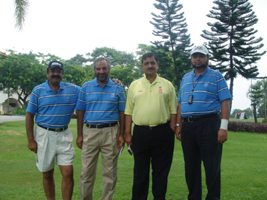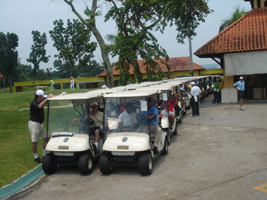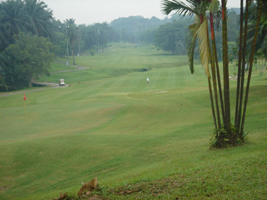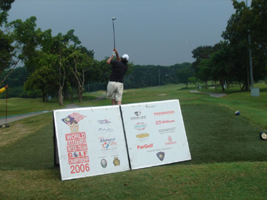center. We were not playing at night but were scheduled
for lunch and a 1:30pm tee off time.
Today’s lunch was provided in the beautiful 3-level
Club House which also houses a golf reception/administration center,
pro shop, changing rooms, caddy & buggy stations, VIP suite, function
rooms, viewing galleries and a very large dining area with a private
banquet room. We had the privilege today of lunching
in the private dining room reserved for both groups. Ours,
which had yet to play and the incoming group of
”World Amateurs” that were about to complete their six month shoot-out.
Today our own little tournament appeared to be
a bit more serious with carts set aside and caddies in readiness.
All in all, there were over forty golfers from the nine countries
represented today: Korea; Pakistan; Indonesia; China; Thailand; Australia;
Japan; America and of course, Malaysia. Other countries represented
with the World Golf Amateurs (but not with us) were from Brunei; Singapore;
Taiwan; New Zealand and South Africa. As it turned out I was
again teamed with my Australian partner Howard from a couple of days
ago and a new team player, Tan from Indonesia.
Play was set up for a shot gun start with our designated
tee off on Sultan Nine at hole number six. The #6 tee box was placed well above the hole which looked down to a tricky green
one hundred and fifty three yards distant. None of us hit the
green but all three shots were close. A short hole tee off was
a good confidence builder to attack the challenging 6,332 yard course.
box was placed well above the hole which looked down to a tricky green
one hundred and fifty three yards distant. None of us hit the
green but all three shots were close. A short hole tee off was
a good confidence builder to attack the challenging 6,332 yard course.
The formidable #7 hole of 472 yards followed.
It was a par five which I thought was rated a bit high at only a seven
index difficulty. It bent left from tee to green with
water that cut the fairway in half at the 369 yard mark. The
next two par 5’s were hole #12 with an eight index rating and the
number sixteen hole at 554 yards rated as the second toughest--which
I whole hardily agreed with. It had water in front of the tee
box and a pond that cut the fairway in half at the 284 yard mark.
It took awhile for us to play around to the #2
hole, but we were already aware of its notoriety. It was designated
as the to ughest
on the course and was aptly nicknamed the “Dragon”. A five hundred
and fifteen yard downhill narrow fairly with water bordering the left
side and then cutting across the entire fairway. Then it went
uphill to the green that sat on a plateau blocked by four bunkers.
ughest
on the course and was aptly nicknamed the “Dragon”. A five hundred
and fifteen yard downhill narrow fairly with water bordering the left
side and then cutting across the entire fairway. Then it went
uphill to the green that sat on a plateau blocked by four bunkers.
Our scores didn’t reflect the well attended holes
even though our caddies knew the greens like the back of their hands.
“Putt right two ball” or “three ball left”[sic]. On one occasion
the caddie marked a spot for me to hit to about 20 feet distant where
the break to the hole would be. I followed his advice and hit
it square on the spot he told me to hit it, but it stopped right there
leaving me another 8 feet to the hole. He and I looked at each
another and laughed at my ability to hit the exact spot he had pointed
to yet neglected to hit it hard enough to make the break. My
golf partners wondered what was so funny about my missing the putt.
And so it went--good shot--good shot--bad shot—good—bad,
rhetorically asking myself why I couldn’t be more consistent?
Possibly a question asked by every golfer to one degree
 or
another. Howard was also inconsistent, but that’s why we were
listed as 24 handicappers. All in all, water didn’t threaten
as much as all the sand (in traps) which could have covered a small
beach.
or
another. Howard was also inconsistent, but that’s why we were
listed as 24 handicappers. All in all, water didn’t threaten
as much as all the sand (in traps) which could have covered a small
beach.
In particular, the hole number plaques at each
tee were attractive and informative. One such plaque (on Hole #1)
rated the green speed at 8.0. I don’t know where 8.0 rates on
the “stimpometer”, but since it was the only hole on the course with
this notation, I guess it may be decoded as a difficult putting surface?
Then somewhere in the middle of the play The Blue Mosque loudspeaker
went into action with its daily call to prayer. I hesitate to
say this, but the only praying among this group was for the ball to
go into the cup.
Both the Alam Shah Nine and the Sultan Nine lived
up to expectations…lovely scenery, well maintained fairways, challenging
holes and nicely attended greens. Plus it was a beautiful
day to play this course. There is a sign near the club
house that explained that they use “Tour Turf” throughout the course.
The sign clarified the use of “a synthetic surface that looks, feels
and plays like grass.” I’m certain that I encountered it on
the course but I didn’t note any difference in surface…which proves
their point quite well.
 The tournament concluded that night with a massive
banquet dinner where there was good fellowship among all the nationalities
represented. Although we were also awarded prizes for our tournament
the main event was the conclusion of the 2006 World Amateur Inter-Team
Golf Championship. Our group acted more or less as observers
to the concluding awards presented to the final three teams.
After six months of elimination rounds a team from Australia took
top honors, followed by Pakistan in second place and Malaysia in third.
The tournament concluded that night with a massive
banquet dinner where there was good fellowship among all the nationalities
represented. Although we were also awarded prizes for our tournament
the main event was the conclusion of the 2006 World Amateur Inter-Team
Golf Championship. Our group acted more or less as observers
to the concluding awards presented to the final three teams.
After six months of elimination rounds a team from Australia took
top honors, followed by Pakistan in second place and Malaysia in third.
The next day when most of the golfers departed
I had an opportunity to visit the Capital City of Kuala Lumpur (see
the article on Malaysia under the Travel section on this site.)
It was good fun and a great trip.
For more information on KGSAAS visit their web
site www.kgsaas.com
* On http://www.waitgc.com/the
details to play in the 14th annual tournament will be posted.
A few of the details are: Registration fee is $1500 per
team of four players. The fee includes 5 nights lodging, air
transfers, breakfast, welcome party, four rounds of golf and dinner.
The game is both gross and net score over 54 holes. To enter
the competition a valid minimum handicap is18 or less for males and
24 or less for females.
Finalists from approximately 20 countries will
compete over six elimination rounds beginning February 12, 2007 and
continuing until July 12, 2007 at various golf clubs throughout Malaysia.
Each group of winners comprising 30 teams will advance to the Grand
Final August 28, 2007. Malaysia is a very long way and
certainly it’s a foreign country. The time change and the cost
are good reasons not to play, or maybe they’re excuses. Seventy
percent of the teams are from outside Malaysia, but no U.S. teams
competed in the recently concluded 2006 tournament.
I’ll put the call in here and now for four very
good USA amateur golfers—college or just friends—to play in a tournament
in Malaysia and see if they can win against other countries. The
year 2007 will also be a once-in-a-lifetime opportunity to visit and
help Malaysia celebrate its 50th Year of Nationhood.